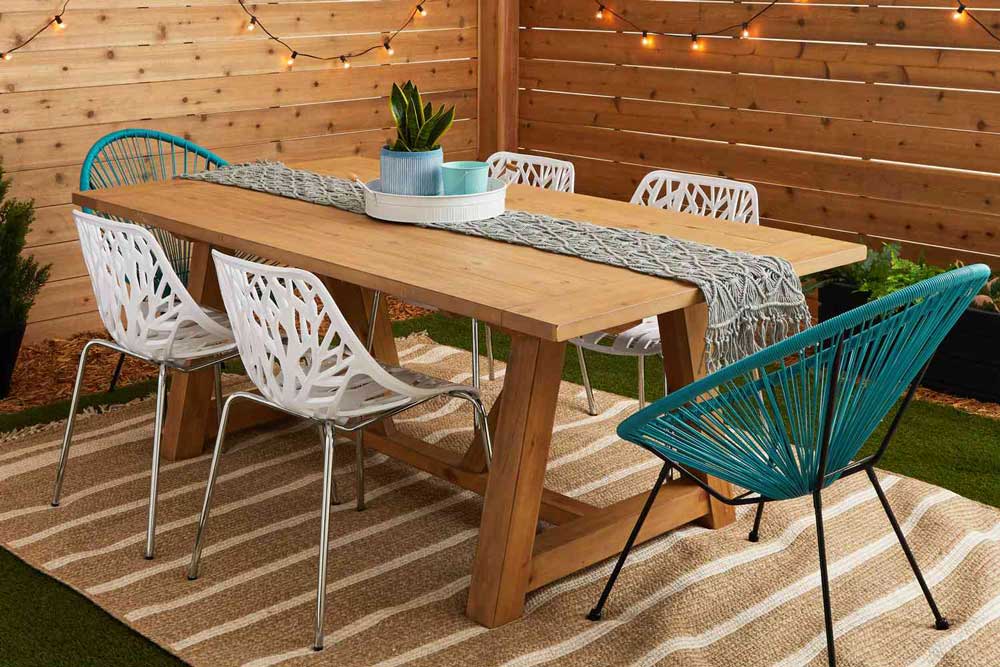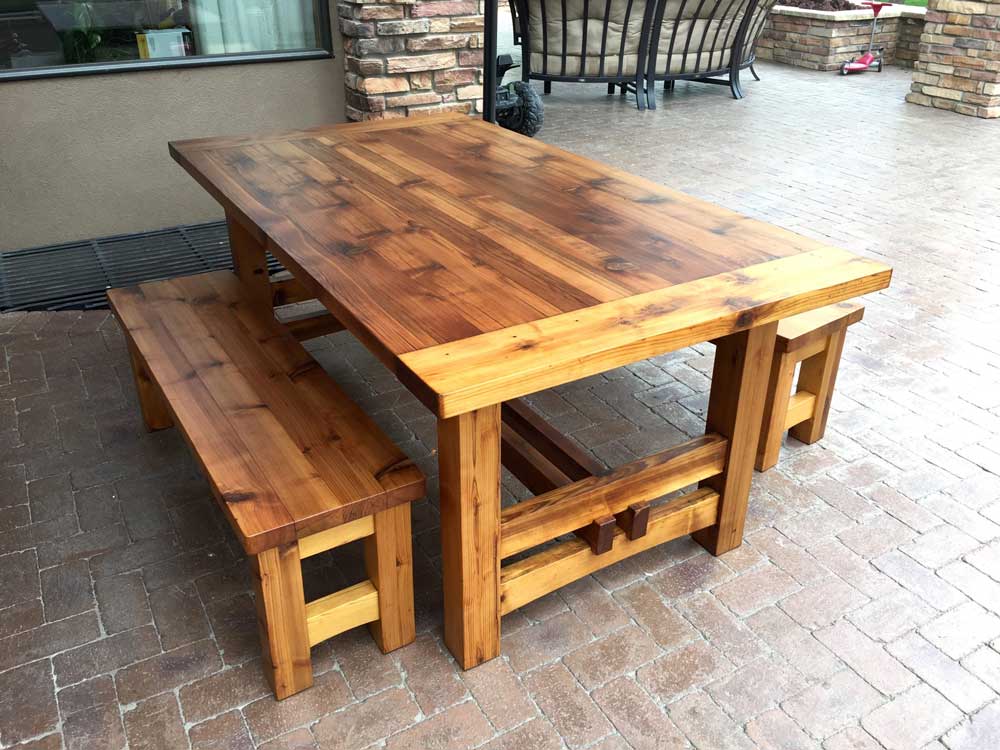Introduction
One noticeable trend has evolved as modern house design continues to change: the rising appeal of wooden tables. The impact of natural elements on aesthetics has captivated both homeowners and interior designers, which has resulted in a renewed appreciation for the traditional allure of wooden tables.
Historical Significance of Wooden Tables
It is necessary to trace the cultural origins of wooden tables throughout civilizations in order to fully comprehend their significance. Wooden tables have endured the test of time and are still significant in today’s design environment, from ancient Egypt and Greece to medieval Europe. Their ability to blend in with a variety of design styles and endure for millennia is evidence of their enduring appeal.
Evolving Design Trends

In the middle of the shift from modern to rustic tastes, homeowners are accepting faults in furniture. Wooden tables have come to represent this change because of their allure and distinctive qualities. Furniture that emphasizes simplicity, organic textures, and the classic charm of wooden tables is currently popular.
Embracing Sustainability with Wooden Tables
The chance to support sustainability is one of the main benefits of choosing wooden tables. Homeowners can lessen their carbon footprint and aid in the preservation of our planet’s forests and wildlife by selecting wood that has been sourced ethically. Those who want to make their homes more environmentally friendly will surely find the eco-friendly benefits of hardwood tables appealing.
The Versatility of Wooden Tables in Interior Design
Wooden tables naturally have the capacity to warm up a space and quickly become the center of attention in any space. Wooden tables have the unusual capacity to fit into numerous interior design ideas, whether they are coupled with modern or historical furniture. Wooden tables are highly adaptable, working in both modern and minimalist settings.
The Allure of Natural Beauty

The natural beauty of hardwood tables is one of their most alluring features. Each table is distinctive due to the variances in the wood grain, ensuring that no two are alike. Stains, treatments, and patinas provide homeowners the chance to highlight the uniqueness and appeal of wood as a material while enhancing the natural character of their wooden tables.
Functional Excellence of Wooden Tables
When purchasing furniture, durability is an important consideration, and hardwood tables must exceed expectations in this area. They are a good long-term investment for homeowners because of their durability. Additionally, since hardwood tables can withstand frequent usage without sacrificing design or utility, they are perfect for families and events. Additionally, homeowners may customize their wooden tables to suit their own needs and tastes thanks to the variety of sizes, forms, and designs available.
Maintaining and Preserving Wooden Tables
The longevity and quality of wooden tables depend on using the right cleaning methods. Homeowners should become familiar with effective cleaning techniques that safeguard and preserve the wood. Wooden tables will also look their best for years to come if you know how to handle typical problems like scratches and stains.
Design Inspirations for Wooden Table Incorporation
Wooden tables work especially well in farmhouse-style settings, where they may easily blend in with antique furnishings. These tables’ rustic appeal gives the rooms more personality and coziness. Wooden tables also stand out in Scandinavian minimalism, providing a chic and understated accent that perfectly matches the style.
The Emotional Connection with Wooden Tables

Beyond being aesthetically pleasing, wooden tables have a special capacity to elicit emotion and promote connections. They become the center of family get-togethers and shared experiences, acting as a tangible reminder of cherished memories and customs. Wooden tables offer a place for meeting where loved ones can deepen their relationships and make new memories.
Case Studies: Exemplary Wooden Table Installations
Examining case studies exhibiting excellent design synergy and distinctive usage is helpful in understanding the transformative impact of wooden tables. Readers can ensure that their wooden tables become the focal point of their interior design by taking inspiration from these successful examples and applying similar techniques to their own settings.
Addressing Prevalent Misconceptions
Wooden table upkeep and suitability for various home settings are subject to a number of myths. It’s important to refute these misconceptions and offer information to homeowners thinking about buying wooden tables. By addressing concerns and showcasing the adaptability of wooden tables, people may decide for themselves whether to use them in their homes.
Caring for the Environment: Ethical Considerations
Prioritizing eco-friendly solutions is vital when selecting wooden tables. Homeowners should search for certificates and labeling that show their building components were sourced sustainably. Additionally, promoting the use of recycled wood is a responsible design strategy that will help preserve our environment and cut down on waste.
The Future of Wooden Tables in Design

Wooden tables are still at the forefront of these advancements as design industry innovation pushes the boundaries. The popularity of hardwood tables in interior design is on the rise and doesn’t appear to be slowing down as techniques advance and fashions change. The distinctive and intriguing possibilities that lie ahead are eagerly anticipated by design fans.
Summary: The Enduring Appeal of Wooden Tables
There are several important reasons why wooden tables continue to be prominent in contemporary interior design. Wooden tables add a transforming element to any room because of their warm aesthetic, effortless integration into a variety of design styles, enduring beauty, and superior functionality. Exploring the adaptability and attractiveness of wooden tables is an invitation for readers to create genuinely captivating settings in their homes as they embark on their own design journeys.
You May Also Like:
-
Elevate Your Lifestyle With Smart Wood Furniture Innovations – Hardiko
-
The Future Of Interior Design: How Engineered Wood Furniture Is Reshaping Homes – Hardiko
-
Budget-Friendly Bliss: Elevate Your Decor With Affordable Pine Wood Furniture – Hardiko
-
Online Furniture Store से फर्नीचर खरीदने के फायदे – Hardiko
FAQs About Wooden Tables
Q1. What are the benefits of choosing a wooden table for my home?
A wooden table offers several benefits, including:
Aesthetic Appeal: Wooden tables add warmth, elegance, and a timeless charm to your home décor.
Durability: High-quality wooden tables are sturdy and can last for generations with proper care.
Variety: Wood comes in various types, grains, and finishes, allowing you to choose a table that matches your style.
Customization: Wooden tables can be customized in terms of size, shape, and design to fit your specific needs.
Versatility: They can be used in various settings, from dining rooms to offices, and blend well with different interior themes.
Q2. How do I maintain and clean my wooden table?
Maintaining your wooden table is essential for its longevity. Here’s how:
Regular Dusting: Use a soft, lint-free cloth to dust the surface regularly, preventing the buildup of dirt and debris.
Avoid Moisture: Wipe up spills promptly to prevent water damage. Use coasters and placemats to protect the table from moisture.
Gentle Cleaning: For cleaning, dampen a cloth with a mixture of mild soap and water. Wipe the table gently and dry it immediately.
Polishing: Periodically apply a furniture polish or wax specifically designed for wood to maintain its luster and prevent drying.
Sunlight Exposure: Avoid placing the table in direct sunlight, as prolonged exposure can cause fading and warping.
Q3. Are there different types of wood used in making wooden tables?
Yes, there are several types of wood commonly used for making wooden tables, each with its own characteristics.
Oak: Known for its durability and distinctive grain patterns, oak is a popular choice. It can be stained in various shades.
Maple: Maple wood is smooth and has a fine, even grain. It’s often chosen for its light color and versatility in staining.
Walnut: Walnut wood offers rich, dark hues and a luxurious appearance. It’s prized for its natural beauty.
Cherry: Cherry wood develops a warm, reddish-brown patina over time. It’s cherished for its elegance and aging process.
Pine: Pine is a softer wood with a rustic charm. It’s often used for farmhouse-style tables and can be stained in different colors.
Q4. How do I prevent scratches and dents on my wooden table?
Preventing scratches and dents will help keep your wooden table looking pristine.
Use Tablecloths or Placemats: When dining, use tablecloths or placemats to create a protective barrier between dishes and the table surface.
Felt Pads: Attach felt pads to the bottom of objects that might be placed on the table, such as vases or decorative items.
Avoid Sharp Objects: Refrain from placing sharp or heavy objects directly on the table to prevent surface damage.
Regular Cleaning: Dust and clean the table regularly to prevent grit and dirt particles from causing scratches during use.
Q5. Can I repair scratches and minor damage on my wooden table?
Yes, minor scratches and damage can often be repaired.
Wood Filler: For small scratches, you can use wood filler that matches the table’s color. Apply it to the scratch, let it dry, and sand it gently.
Touch-Up Pens: Touch-up pens and markers designed for wood can help mask scratches by filling them with color.
Polishing and Buffing: Polishing the surface can help diminish the appearance of minor scratches by blending them with the surrounding area.
Professional Restoration: For significant damage, seeking professional help from a furniture restoration expert is recommended.












5 thoughts on “Why Wooden Tables Are the Hottest Trend in Home Design”